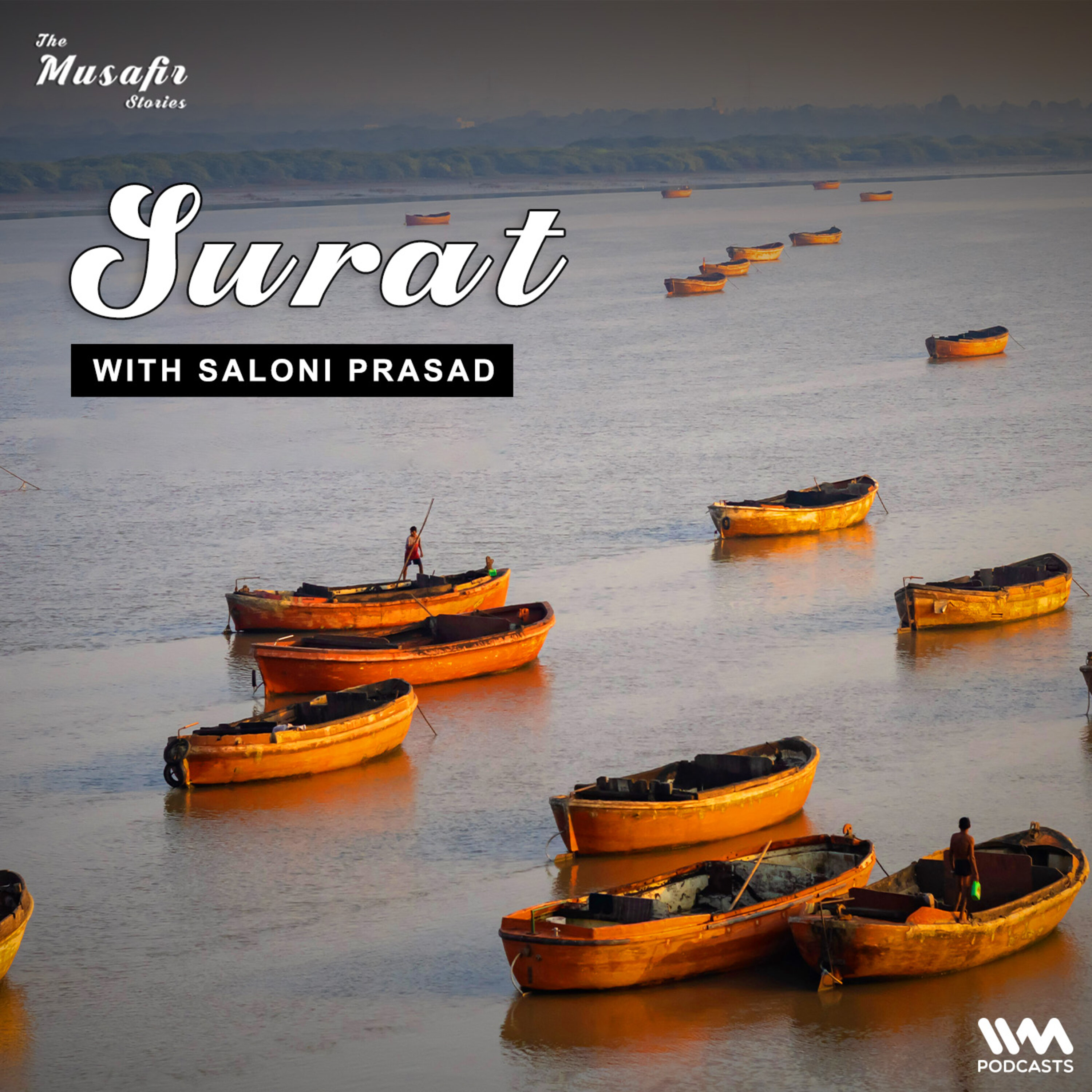
The Musafir Stories - India Travel Podcast
Society & Culture:Places & Travel

This week, The Musafir Stories speaks with Saloni Prasad, curator at the Surat Heritage Project as she talks about the story of Surat, through a fascinating heritage walk!
Today's destination: Surat
Nearest Airport: Surat International Airport (STV)
Nearest Railway Station: Surat Station (ST)
Prerequisites: N/A
Packing: Good walking shoes, carry extra water as it can get hot during the day in the summers
Time of the year: Round the year, check Instagram for details
Length of the itinerary: 2-3 hours
Itinerary Highlights:
- We start off the walk by talking about the history and golden era of Surat - a port town on the banks of river Tapi or Tapti. Although Surat has existed for a long time, the documented history seems to suggest important structures being built around the 14th century.
- The first stop of the walk is the Surat castle or Surat fort, indicating that Surat was once a walled city and is believed to have been built during the time of Gujarat Sultanate in the 16th century by a Turkish governor/general turned associate of the ruler, Khudavand Khan. The remaining structure is now a museum and has several interesting galleries, including a gallery of archives, textiles, pictures, and woodwork among others.
- From the Surat fort, we move to Andrew’s library, built over 200 years ago during the British rule of the city and is a functional library. Close to the library is the CNI church or Anglican church, one of the oldest churches in the city built in the 1800s.
- The banks of the river Tapi are in the vicinity and one can walk here to experience the ghats of Surat. We also speak of the first warehouse of the British in India that was built in this region, although the warehouse/factory doesn’t exist anymore but is a marker of an important landmark in Indian history.
- We also talk briefly about the battle of Swally which is not too far away from here - one of the first battles between the Portuguese and the British forces fighting on the side of the Moguls. Another iconic event that perhaps does have long-lasting repercussions similar to the battle of Plassey.
- We speak about the Ghanta ovara, custom house and mint house and how a day in the ancient port city would’ve looked like.
- The next stop is the Mughalsarai, which is currently the office of the SMC or Surat Municipal Corporation. The original building was built as a travel lodge or musafir khana - primarily used as a hostel for pilgrims who would board ships to Mecca. This was built by Jahanara, the eldest daughter of Shah Jahan.
- The final stop is the tomb of Khudavand Khan, the man who built the Surat Fort - we talk about his origins in Turkey, how he ended up in Surat and what one can see at the tomb.
- We also discuss the unmissable local street food of Surat as well as the various communities that have made Surat so cosmopolitan.
- We end the episode discussing some other interesting walks offered by the Surat Heritage project, including walks in Rander, Swally, Dumas, and British and Dutch cemeteries among others.
Links:
Link to Surat Heritage Project’s Instagram:
https://www.instagram.com/surat.heritage.project/
Link to Saloni’s Instagram:
https://www.instagram.com/the.turquoise.ink
Link to website:
https://www.suratheritage.com/
Photo by VD Photography on Unsplash
Follow the Musafir stories on:
Twitter : https://twitter.com/musafirstories?lang=en
Facebook: https://www.facebook.com/themusafirstories/
Instagram: https://www.instagram.com/musafirstoriespodcast/?hl=en
website: www.themusafirstories.com
email: themusafirstories@gmail.com
Do follow IVM Podcasts on social media.
We are @IVMPodcasts on Facebook, Twitter, & Instagram.
Follow the show across platforms:
Spotify, Google Podcasts, Apple Podcasts, JioSaavn, Gaana, Amazon Music
Do share the word with your folks!
See omnystudio.com/listener for privacy information.
More Episodes
 2023-08-17
2023-08-17
 2023-08-03
2023-08-03
 2023-07-20
2023-07-20
 2023-07-06
2023-07-06
 2023-06-22
2023-06-22
 2023-05-25
2023-05-25
 2023-03-16
2023-03-16
 2023-03-02
2023-03-02
 2023-02-16
2023-02-16
 2023-01-19
2023-01-19
 2023-01-05
2023-01-05
 2022-12-08
2022-12-08
 2022-11-24
2022-11-24
 2022-11-10
2022-11-10
 2022-09-29
2022-09-29
 2022-09-15
2022-09-15
Create your
podcast in
minutes
- Full-featured podcast site
- Unlimited storage and bandwidth
- Comprehensive podcast stats
- Distribute to Apple Podcasts, Spotify, and more
- Make money with your podcast
It is Free
- Privacy Policy
- Cookie Policy
- Terms of Use
- Consent Preferences
- Copyright © 2015-2024 Podbean.com





